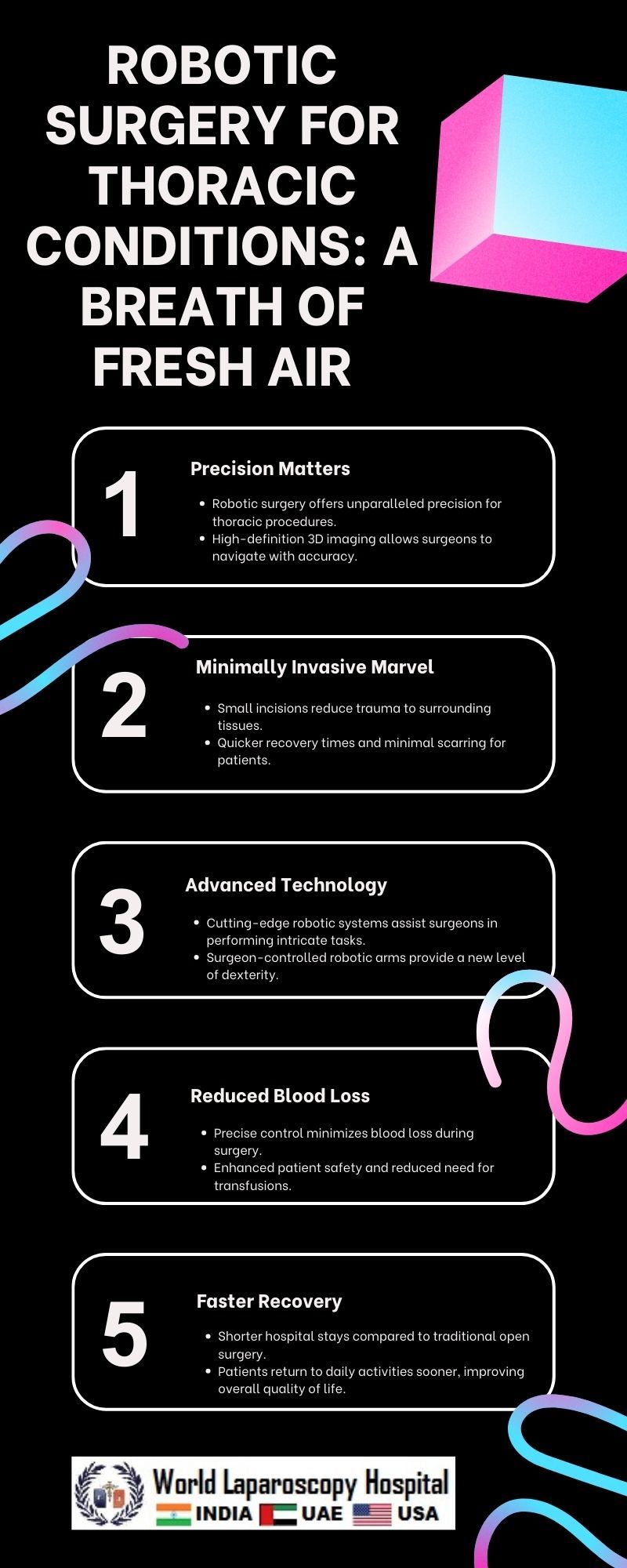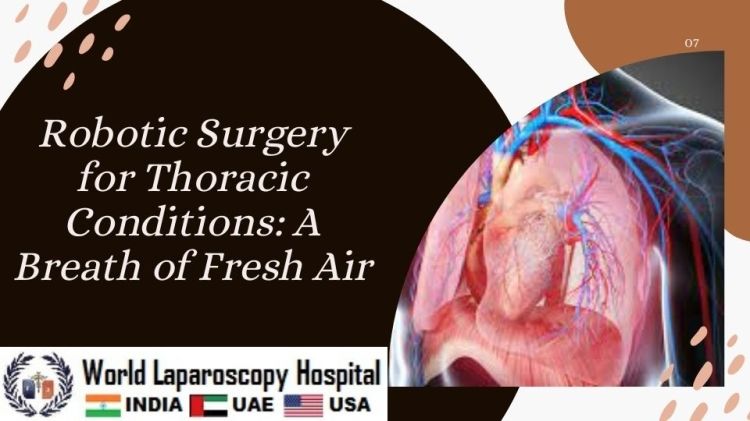Robotic Surgery for Thoracic Conditions: A Breath of Fresh Air
Introduction:
In recent years, the field of surgery has witnessed a paradigm shift with the introduction and rapid advancement of robotic technology. One of the areas where this innovation is making a significant impact is in the treatment of thoracic conditions. Robotic surgery has emerged as a breath of fresh air, revolutionizing traditional approaches to thoracic procedures and offering patients new hope for improved outcomes.

Understanding Thoracic Conditions:
Before delving into the nuances of robotic surgery, it's essential to comprehend the scope of thoracic conditions. The thoracic region encompasses the chest, housing vital organs such as the heart, lungs, and esophagus. Conditions affecting this area range from benign tumors and cysts to more complex issues like lung cancer and esophageal disorders.
Traditional Thoracic Surgery:
Historically, thoracic surgeries involved open procedures, necessitating large incisions and prolonged recovery times. While effective, these methods often led to increased pain, longer hospital stays, and a higher risk of complications. The quest for less invasive alternatives paved the way for minimally invasive techniques, including laparoscopic and thoracoscopic procedures.
Enter Robotic Surgery:
Robotic surgery represents the latest evolution in minimally invasive procedures. Utilizing robotic systems like the da Vinci Surgical System, surgeons can perform complex thoracic surgeries with unparalleled precision. The system consists of robotic arms controlled by a console, translating the surgeon's hand movements into precise actions within the patient's body.
Advantages of Robotic Surgery in Thoracic Procedures:
Precision and Dexterity:
One of the primary advantages of robotic surgery is the enhanced precision and dexterity it offers. The robotic arms can make intricate movements with a range of motion that surpasses the human hand. This is particularly crucial in thoracic surgeries where delicate structures like blood vessels and nerves need meticulous handling.
Minimally Invasive Approach:
Robotic surgery reduces the need for large incisions, opting for small keyhole openings instead. This minimally invasive approach results in less trauma to surrounding tissues, decreased blood loss, and quicker recovery times for patients. Smaller incisions also contribute to a more cosmetically appealing outcome.
3D Visualization:
The robotic system provides three-dimensional, high-definition visualization of the surgical site. This level of clarity enables surgeons to navigate through complex anatomical structures with greater ease, contributing to safer and more effective procedures.
Reduced Complications:
With improved precision and a minimally invasive approach, robotic surgery has shown a reduction in postoperative complications. Patients undergoing thoracic procedures through robotic means often experience fewer infections, reduced pain, and a quicker return to normal activities compared to traditional surgery.
Quicker Recovery Times:
The minimally invasive nature of robotic surgery translates to shorter hospital stays and faster recovery times. Patients can resume their daily activities sooner, enhancing their overall quality of life post-surgery.
Applications in Thoracic Surgery:
Robotic surgery has found applications in various thoracic procedures, addressing both benign and malignant conditions.
Lung Cancer Resection:
Lung cancer, a prevalent thoracic condition, often requires surgical intervention. Robotic-assisted lung resection allows for precise removal of tumors while preserving healthy lung tissue. This approach is associated with reduced postoperative pain and quicker recovery.
Esophageal Surgery:
Disorders of the esophagus, such as esophageal cancer or gastroesophageal reflux disease (GERD), can be effectively treated with robotic surgery. The system's flexibility and precision aid surgeons in intricate procedures, including esophagectomy and fundoplication.
Thymectomy:
Robotic thymectomy, the removal of the thymus gland, is a common procedure for treating thymic tumors and myasthenia gravis. The robotic system's ability to access tight spaces and perform precise movements is advantageous in thymic surgeries.
Mediastinal Tumor Resection:
Tumors within the mediastinum, the central compartment of the chest, can be challenging to access. Robotic surgery facilitates the removal of these tumors with minimal invasiveness, reducing the risk of damage to adjacent structures.
Challenges and Considerations:
While robotic surgery offers numerous benefits, it is essential to acknowledge certain challenges and considerations associated with this technology.
Cost:
The initial setup and maintenance costs of robotic systems can be substantial. This has raised concerns about the accessibility of robotic surgery, particularly in healthcare settings with limited financial resources.
Training Requirements:
Operating a robotic system requires specialized training for surgeons. As the technology evolves, continuous education is essential to ensure optimal utilization and proficiency in robotic-assisted procedures.
Limited Haptic Feedback:
Robotic surgery currently lacks the full sense of touch that surgeons experience in traditional procedures. Although advancements are being made in haptic feedback systems, the tactile sensation provided by robotic instruments is still limited compared to direct manual touch.
Patient Selection:
Not all patients are suitable candidates for robotic surgery. Factors such as body habitus, previous surgeries, and the specific nature of the thoracic condition play a role in determining the appropriateness of robotic-assisted procedures.
Future Directions and Innovations:
The landscape of robotic surgery for thoracic conditions continues to evolve, with ongoing research and innovations aimed at addressing current limitations and expanding the scope of applications.
Artificial Intelligence Integration:
Integrating artificial intelligence (AI) into robotic systems holds the potential to enhance decision-making during surgery. AI algorithms can analyze real-time data, providing surgeons with valuable insights and improving overall procedural outcomes.
Augmented Reality:
The incorporation of augmented reality (AR) into robotic surgery could revolutionize the visualization aspect. Surgeons may benefit from enhanced navigation and guidance through three-dimensional holographic images overlaid onto the surgical field.
Remote Surgery:
The concept of remote robotic surgery, where a surgeon operates on a patient located at a different physical location, is a frontier being explored. This could prove invaluable in providing specialized care to patients in remote areas or during emergency situations.
Enhanced Haptic
Feedback: Research efforts are underway to improve the haptic feedback experienced by surgeons during robotic procedures. Advanced haptic systems aim to replicate the sense of touch more accurately, further bridging the gap between traditional and robotic surgery.
Conclusion:
Robotic surgery for thoracic conditions represents a transformative leap forward in the realm of medical interventions. The precision, minimally invasive approach, and improved patient outcomes associated with robotic-assisted procedures have made it a promising avenue for the future of thoracic surgery. While challenges exist, ongoing research and technological advancements continue to refine and expand the capabilities of robotic systems, offering new hope and possibilities for patients facing thoracic conditions. As this field continues to evolve, the collaboration between surgeons, engineers, and researchers will play a pivotal role in shaping the future of robotic surgery and its impact on thoracic medicine.
